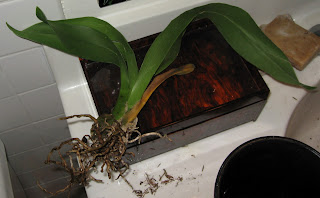I love orchids. They are beautiful, long-lasting, often fragrant bloomers. For myself and many other gardeners they seem impossibly challenging, yet we feel drawn to them just the same.
I must confess that I've also been an orchid killer. Serial killer even, by sheer numbers. But that was then...
...this is now. For some reason, the sheet-filtered, southern exposure light in my apartment has been a haven for this lovely Phalaenopsis 'Happy Girl' (helping her live up to the name).
When I purchased this orchid on March first of this year, it had a couple flowers and several buds (some of which fell off promptly after the trip home from the store.)
In its' blooming heyday this past June, it looked like this....
...with the final bloom just dropping off on August 31st!
Bolstered by this success I got excited and bought 8 more orchids to
try not to kill grow and enjoy. One purchase, Miltassia 'Kauai's Choice Pacific P' had arrived stuffed into a small plastic pot and needs a new home. Thus begins the apothecary funnel orchid planter experiment. This big glass funnel was an Ebay purchase billed as a "Vintage Glass Hanging Apothecary Mortician Embalming Funnel"...I just thought it was cool as hell. It measures
13 1/4" tall, with the mouth being approx. 5 3/8" in diameter, and I felt that the funnel could help to keep my overwatering tendancies in check. (Plus it comes with this metal hanger and will look wicked cool with my other plants! :)
The orchid to call this funnel home. Has some dead stuff I'll trim off, but otherwise seems healthy and good to go.
My potting supplies include green moss (sphagnum), distilled water, and spanish moss...
...along with a "large chunk orchid mix" I bought on Ebay. I pre-soaked the mix and some sphagnum moss in distilled water before potting (chunks overnight and moss about 15 minutes).
I began the layering with the dry spanish moss to promote drainage and airing out...
...then a layer of the potting mix...
...which is comprised of
pine bark, clay aggregate and volcanic ash rock in chunks from 1/2" to 1".
Atop this layer is some of the wet sphagnum moss...
...then more chunks and so on like a parfait...
...with and orchid on top. There are two bulbils so I spaced them out a bit.
There! The excess moisture will drip out into this enamel photo developing pan containing another orchid, Cymbidium 'Suzie Q'. I'm keeping Suzie fairly wet because she's a terrestrial orchid and I tend to let these (like carnivorous plants) dry out too much. So I'm banking that handling them equally may be my key to success (or not, whatever :)
I have the orchids way at the top so that they can dry out some, and yet send roots lower into more moisture as they wish.
The rest of my orchid population include (from left): Tolumnia 'Tequila Sunrise', Cattleya 'Hawaiian Passion Carmela', and Cattleya 'Summer Spot Carmela'.
Tolumnia arrived in spike and the bloom buds seem to have survived the trip.
I found it difficult to resist some well priced mounted orchids too. This is Brassavola nodosa, the fragrant 'Lady of the Night' orchid...
...and Oncidium 'Aliceara Alice' mounted on Cork Bark...
...and finally Maxillaria Tenuifolia Mounted on Driftwood.
Several bulbils here, and they can all be propagated into more plants....
...but for now I'll leave well enough alone (lest they begin to fall ill or succomb to the deadly touch of the rank ameteur orchidist). Only time will tell....









































